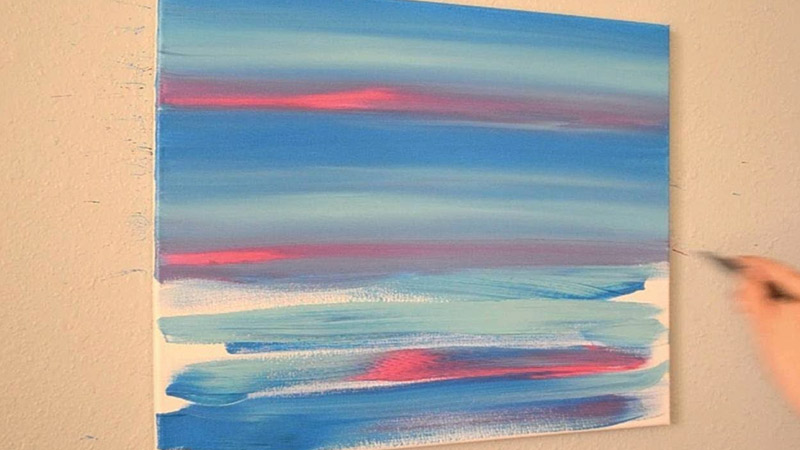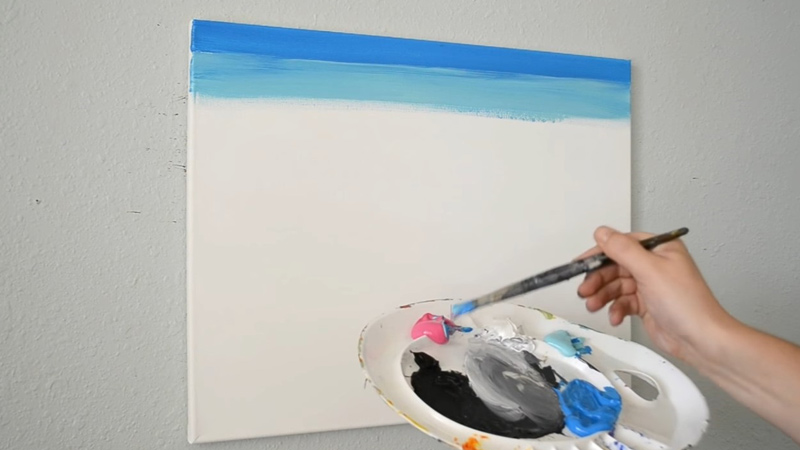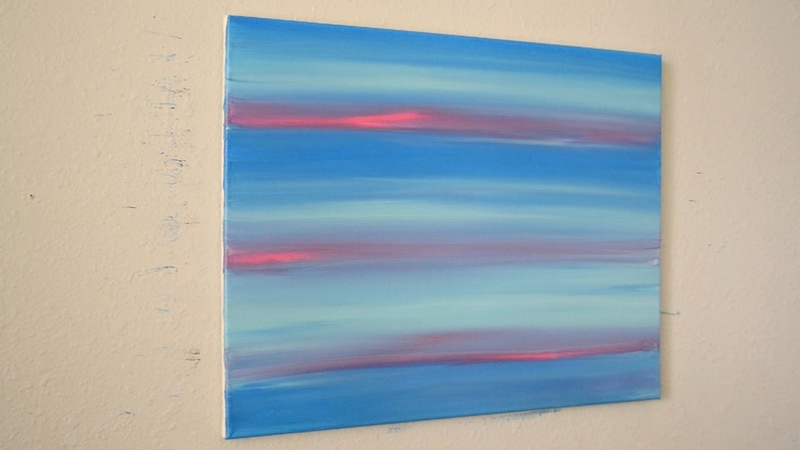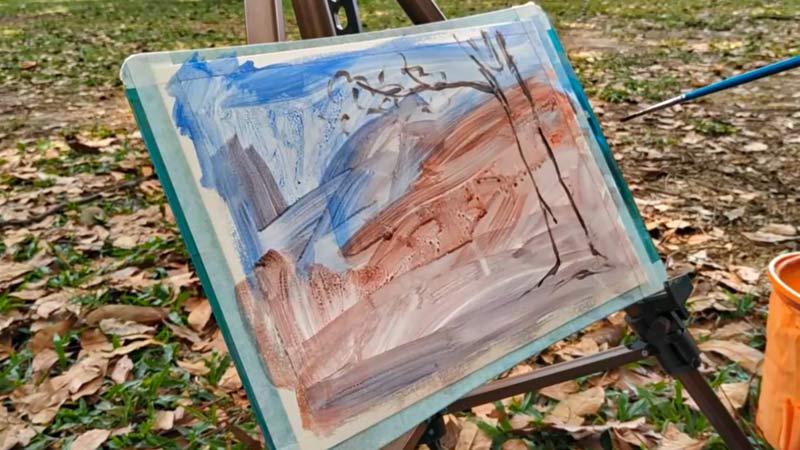Acrylic paint is a beloved medium among artists for its versatility and vibrant color possibilities. However, for both beginners and experienced, the frustration of encountering streaky results in your acrylic paintings is a common challenge faced by many artists and people say, “why is my acrylic paint streaky?”
So, understanding the reasons behind this phenomenon is crucial in overcoming it. Streakiness in acrylic paint can manifest as uneven color distribution, visible brush marks, or an unsightly patchy appearance, detracting from the intended visual impact of your artwork.
In this exploration, we will delve into the various factors contributing to streaky acrylic paint, ranging from issues like inadequate mixing and low-quality paint to improper techniques and surface preparation.
By unraveling these mysteries, we can unlock the secrets to achieving smoother, more even acrylic paintings and enhance our artistic expressions.

10 Reasons Why Your Acrylic Paint Looks Streaky
When using acrylic paint, one common frustration that artists encounter when working with acrylics is the issue of streakiness. Streaky acrylic paint can be frustrating, but understanding the reasons behind it can help you avoid and rectify this problem in your artwork.
Here are the causes that make your acrylic paint look streaky:
Inadequate Mixing
One of the primary reasons why acrylic paint can appear streaky is improper mixing. If you don’t mix the paint thoroughly, pigments can settle at the bottom of your paint container, leading to uneven distribution of color. Always ensure you mix your acrylics well before applying them to your canvas or surface.
Low-Quality Paint
Not all acrylic paints are created equal. Lower quality paints may contain less pigment, leading to streakiness. Investing in higher-quality acrylic paints with more pigment content can result in smoother and more even application.
Insufficient Layers
Applying a single thin layer of acrylic paint can often result in streakiness. To achieve a more even and opaque finish, consider layering your paint. Multiple thin layers can help you build up the color and create a smoother appearance.
Overworking the Paint
Acrylic paint dries quickly, which can be a double-edged sword. If you spend too much time working a particular area or repeatedly over-brush the paint, it can start to streak. To prevent this, work efficiently and avoid going back over a previously painted area once it has started to dry.
Inappropriate Brushes
The type of brush you use can also affect how acrylic paint appears on your surface. Stiff-bristle brushes can leave streaks, especially if you’re using them for fine details. Experiment with different brush types and choose those that suit your painting style and desired texture.
Surface Preparation
The surface you’re painting on matters. If your canvas or substrate isn’t properly primed or prepared, it can absorb the paint unevenly, leading to streaks. Ensure your surface is adequately primed and ready for acrylic paint application.
Using Too Much Water

Acrylic paints can be thinned with water, but adding too much water can dilute the pigments and make the paint streaky. If you need to thin your acrylics, use a proper acrylic medium or a controlled amount of water to maintain the paint’s consistency.
Inconsistent Brush Strokes
Irregular and inconsistent brush strokes can contribute to streaky paint. Try to maintain a steady and even hand while applying your acrylics. Using a palette knife or a sponge can also help achieve a smoother texture.
Drying Time
If you work on an area that has already dried partially, the new layer of paint may not adhere properly, resulting in streaks. Keep track of your paint’s drying time and avoid overlapping wet and dry areas.
Lack of Patience
Rushing through your painting process can lead to streaky results. Take your time, allow layers to dry between applications, and be patient in building up your artwork.
How to Fix Streaky Paint?
Fixing streaky paint can be a frustrating but manageable task. Whether you’re working with acrylics, oils, or any other type of paint, the following steps can help you rectify streakiness in your artwork.

Here are the steps on how to make acrylic paint not streaky:
Identify the Cause
Before you can fix streaky paint, it’s essential to understand why it happened. Review your painting process and materials to pinpoint the root cause. Common causes include inadequate mixing, low-quality paint, overworking the surface, or using improper techniques.
Let it Dry
If the streaks are due to overworking wet paint, the first step is to let the paint fully dry. Trying to fix it while it’s still wet can exacerbate the issue.
Layering
Consider applying additional layers of paint. This can help build up the color and hide streaks. Use thin layers and allow each layer to dry before adding the next. Multiple layers can create a smoother, more even surface.
Re-mix the Paint
When streakiness is caused by unevenly mixed paint, remix the paint thoroughly before applying it. This ensures an even distribution of pigments.
Change Brushes
When you suspect your brush is contributing to streaks, try using a different type of brush. Soft brushes are better for blending, while stiff brushes can create texture. Experiment to find the best brush for your needs.
Use a Palette Knife
Palette knives can be helpful in achieving a smoother texture. You can use them to apply and manipulate the paint on the canvas, reducing brush marks.
Add Medium
Acrylics can be thinned or thickened using acrylic mediums. If your paint is too thin and streaky, add a medium to increase viscosity and improve coverage. Conversely, if it’s too thick, you can add a medium to thin it out.
Sanding
For streaks that are slightly raised or very pronounced, you may consider sanding the surface gently once it’s completely dry. Use fine-grit sandpaper (e.g., 400-600 grit) and be cautious not to damage the canvas or substrate.
Blending and Feathering
To address visible brush marks or harsh transitions, try blending and feathering the paint by using a dry brush or a soft blending tool. This technique can help smooth out the streaky areas.
Practice and Patience
Painting, like any art form, requires practice and patience. Don’t be discouraged by streaky paint; view it as an opportunity to improve your skills. Experiment with different techniques and materials to find what works best for you.
Start Anew
In some cases, especially if the streakiness is extensive or irreparable, it might be best to start over. Learning from your mistakes and beginning with a fresh canvas can lead to a better result.
How to Avoid Streaks When Painting With Acrylics?

Avoiding streaks when painting with acrylics requires careful attention to your techniques and materials.
Here are 12 practical ways to help you achieve a smooth and streak-free acrylic painting:
1. Use High-Quality Acrylic Paints
High-quality acrylic paints contain a greater concentration of pigments, resulting in better coverage and opacity.
Opt for renowned brands and consider investing in artist-grade acrylics for the best results.
These paints tend to have fewer fillers, providing a more vibrant and streak-resistant finish.
2. Prep Your Surface
Preparing your painting surface is crucial. Apply a layer of acrylic gesso to your canvas or substrate to create a smooth and consistent surface.
Gesso also prevents the paint from soaking into the canvas, allowing for better adhesion and preventing streaks.
3. Mix Your Paints Thoroughly
Take your time when mixing acrylic paints. Use a palette knife or a paint-mixing palette to blend your colors thoroughly. Ensure there are no lumps or streaks in the paint, as these inconsistencies can translate onto your canvas.
4. Use the Right Brushes
Experiment with different brush types to find the ones that best suit your painting style. Soft brushes, such as synthetic or sable brushes, are excellent for blending and creating smooth transitions.
Stiff brushes, like bristle brushes, are more suitable for textural effects. Having a variety of brushes at your disposal will give you greater control over your acrylic painting.
5. Control Water and Mediums
Be cautious with the addition of water or acrylic mediums to your paint. Excessive water can lead to streaking by diluting the pigments.
If you need to adjust the consistency of your paint, consider using acrylic mediums designed for this purpose. These mediums maintain the color’s integrity while altering its thickness.
6. Apply Thin Layers
Instead of attempting to cover your canvas with a single, thick layer of paint, build up your colors using several thin layers.
This method not only reduces the likelihood of streaks but also allows you to achieve a more subtle and nuanced effect. Ensure each layer is fully dry before applying the next to prevent blending and streaking.
7. Work Quickly and Efficiently
Acrylics dry rapidly, so it’s essential to plan your painting process and work efficiently. Outline your brush strokes, apply the paint confidently, and avoid unnecessary overworking, which can disturb the surface and lead to streakiness.
8. Blend and Feather
To achieve smooth transitions and reduce visible brush marks, use a dry brush or a soft blending tool to blend and feather the paint. This technique is especially useful when working on gradients, shading, or subtle color transitions.
9. Avoid Overworking
Once acrylic paint begins to dry, avoid going back over it repeatedly. Overworking the paint can disturb the surface, causing streaks and an uneven finish. Plan your brush strokes and make deliberate marks to maintain control.
10. Maintain a Consistent Brush Direction
Consistency in your brush direction is key to achieving a streak-free finish. Avoid changing brush directions too frequently, as this can create visible streaks and brush marks on your canvas.
11. Practice and Experiment
Becoming proficient in acrylic painting takes practice and experimentation. Don’t hesitate to try out different techniques, brush types, and mediums to find what works best for your unique style and artistic vision.
With time, you’ll develop the skills to create beautiful, streak-free acrylic artworks.
12. Inspect Your Work
Periodically step back from your painting to evaluate your progress. This allows you to identify streaks or areas that may require adjustment before they become more challenging to rectify. Frequent inspection can lead to a more polished and streak-free outcome in your acrylic paintings.
FAQS
Can the type of canvas affect streakiness in acrylic painting?
Yes, the canvas texture can influence streakiness.
Does the temperature and humidity of my painting environment matter?
Yes, environmental conditions can impact acrylic painting.
Can using a palette with dried acrylic paint residue affect the new paint layer?
Absolutely, dried paint on your palette can mix with fresh paint, altering its consistency and color, which may contribute to streakiness.
Is there a specific order in which I should apply layers to avoid streaks?
Yes, it’s generally recommended to apply lighter colors first and then gradually build up to darker shades.
How can I avoid streaks when working on large acrylic paintings?
When working on larger surfaces, consider using a larger brush to cover more area efficiently.
Conclusion
In acrylic painting, streakiness can be a frustrating stumbling block, but understanding its causes and how to prevent it can unlock the door to smoother, more satisfying artworks.
We’ve explored a multitude of factors that contribute to streaky acrylic paint, from the quality of materials to your techniques and application methods.
The key takeaway is that acrylic painting is both an art and a science, requiring a delicate balance of skill, patience, and experimentation.
By investing in high-quality paints, meticulous preparation, precise mixing, and thoughtful brushwork, you can minimize streakiness and elevate your acrylic creations to a new level of visual richness and texture.
Remember, each streak is an opportunity to learn and grow as an artist, ultimately leading to more polished and captivating works of art.
Leave a Reply